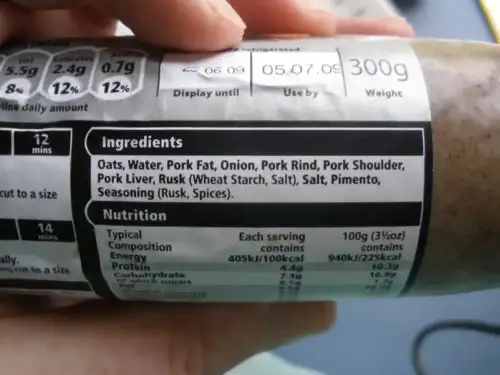Celiac.com 10/10/2024 - In the last decade, the gluten-free food industry has experienced substantial growth, not only in the number of products available but also in consumer awareness. As demand has risen, so too has the need for clear and accurate labeling. For individuals with celiac disease and gluten sensitivity, strict adherence to a gluten-free diet is essential for maintaining health. The ever-evolving landscape of food labeling regulations continues to be a vital topic for those navigating this space. Here’s a breakdown of the most important updates and considerations regarding gluten-free labeling as we head into 2024.
Understanding Gluten-Free: What Does It Really Mean?
To understand gluten-free labeling, it’s important to first clarify what gluten is and why it poses a problem. Gluten is a protein found in wheat, barley, rye, and their derivatives. For people with celiac disease, consuming even trace amounts of gluten can trigger an autoimmune response that damages the small intestine, leading to serious health issues.
Celiac.com Sponsor (A12):
Gluten-free labeling is designed to ensure that foods labeled as such are safe for individuals with gluten-related disorders. According to U.S. Food and Drug Administration (FDA) guidelines, any product labeled as gluten-free must contain less than 20 parts per million (ppm) of gluten. This standard is widely accepted as safe for people with celiac disease. However, not all countries have the same threshold or regulations, making it essential for consumers to understand the rules in the regions where they shop.
Key Changes in Gluten-Free Labeling in 2024
1. More Stringent Cross-Contamination Guidelines
One of the most significant developments in gluten-free labeling for 2024 is the increased focus on cross-contamination. In previous years, gluten-free labeling often referred only to the ingredients used in a product. However, food products could still be contaminated with gluten during manufacturing or packaging. As we move into 2024, new regulations and voluntary certifications are pushing manufacturers to ensure that cross-contamination risks are minimized. This includes more rigorous cleaning processes and dedicated production lines to prevent gluten exposure.
These guidelines are particularly relevant for multi-ingredient products, such as baked goods or processed snacks, where there’s a higher chance that gluten-containing ingredients could be inadvertently introduced.
2. Rise of Gluten-Free Certification Programs
While governmental standards like those from the FDA set minimum requirements for gluten-free labeling, many manufacturers are now seeking third-party certifications to build consumer trust. Programs like the Gluten-Free Certification Organization (GFCO) offer stricter testing and certification processes, often requiring gluten levels to be below 10 ppm or even 5 ppm.
In 2024, more brands are turning to these certifications to differentiate their products in an increasingly competitive market. For consumers, looking for these certification logos can offer an added layer of assurance that the product meets rigorous standards for gluten-free safety.
3. International Differences and Harmonization Efforts
For people who travel or purchase imported goods, it’s important to note that gluten-free labeling standards vary around the world. In the European Union, for example, products must also contain less than 20 ppm of gluten to be labeled gluten-free, but there are additional categories, such as “very low gluten,” which can confuse consumers. In countries like Canada and Australia, the rules are similarly strict but may have slight variations in enforcement.
As the global gluten-free market continues to expand, efforts to harmonize these standards have been gaining traction. In 2024, the World Health Organization (WHO) and the Codex Alimentarius Commission are leading initiatives to develop clearer global standards for gluten-free labeling, aiming to reduce confusion for consumers across borders. These efforts are expected to enhance consumer safety and make it easier for people with celiac disease to shop confidently, regardless of the country of origin of the products they purchase.
4. Digital Tools and Traceability
Another emerging trend in 2024 is the integration of digital tools to verify gluten-free status. Smart labels and QR codes are becoming increasingly common, allowing consumers to scan products with their smartphones to access detailed information about ingredients, testing protocols, and potential cross-contamination risks. These tools provide real-time information that can be updated by manufacturers, offering greater transparency and helping consumers make informed choices.
Traceability systems are also evolving to track a product’s journey from farm to table. This ensures that gluten-free claims are valid throughout the entire supply chain, and not just at the final stage of packaging. Such advancements are especially useful in complex food systems where ingredients might come from multiple sources.
Why Accurate Gluten-Free Labeling Matters
For people with celiac disease, the stakes are high. Ingesting even small amounts of gluten can lead to symptoms ranging from digestive issues to long-term complications like malnutrition, osteoporosis, and an increased risk of certain cancers. Beyond celiac disease, many people suffer from non-celiac gluten sensitivity, which can cause discomfort and other health problems without the autoimmune response seen in celiac disease.
Clear, accurate, and reliable gluten-free labeling is critical to the well-being of millions of people worldwide. The growing popularity of gluten-free diets, sometimes for lifestyle reasons rather than medical necessity, has also led to more products being marketed as gluten-free. However, without proper labeling and adherence to strict standards, there’s a risk that some products might not be safe for those who genuinely need to avoid gluten.
How to Stay Informed and Make Safe Choices
As consumers, staying informed about gluten-free labeling regulations is crucial. Here are a few steps you can take to ensure that the products you choose are truly safe:
- Look for Certification Seals: While any product labeled gluten-free must meet regulatory standards, third-party certifications offer additional assurance that the product has been thoroughly tested.
- Check Ingredient Lists and Allergen Statements: Always review the full list of ingredients and allergen statements. Be on the lookout for terms like “may contain gluten” or “processed in a facility that also processes wheat,” as these could indicate potential cross-contamination risks.
- Use Digital Tools: Take advantage of apps and online resources to verify gluten-free claims. Many platforms offer databases of certified gluten-free products and allow you to scan barcodes for instant information.
- Be Cautious with Imported Goods: If you’re purchasing products from international sources, familiarize yourself with the gluten-free labeling laws in that country. Different regions may have different definitions or thresholds for gluten content.
Conclusion: The Future of Gluten-Free Labeling
As we progress into 2024, gluten-free labeling is becoming more transparent, standardized, and consumer-friendly. New regulations, improved cross-contamination prevention, and technological advances are making it easier than ever to make safe, informed choices. For those living with celiac disease or gluten sensitivity, these developments are not only a convenience but a necessity for maintaining health and well-being. By staying informed and vigilant, consumers can navigate the evolving gluten-free landscape with confidence.













Recommended Comments
There are no comments to display.
Create an account or sign in to comment
You need to be a member in order to leave a comment
Create an account
Sign up for a new account in our community. It's easy!
Register a new accountSign in
Already have an account? Sign in here.
Sign In Now